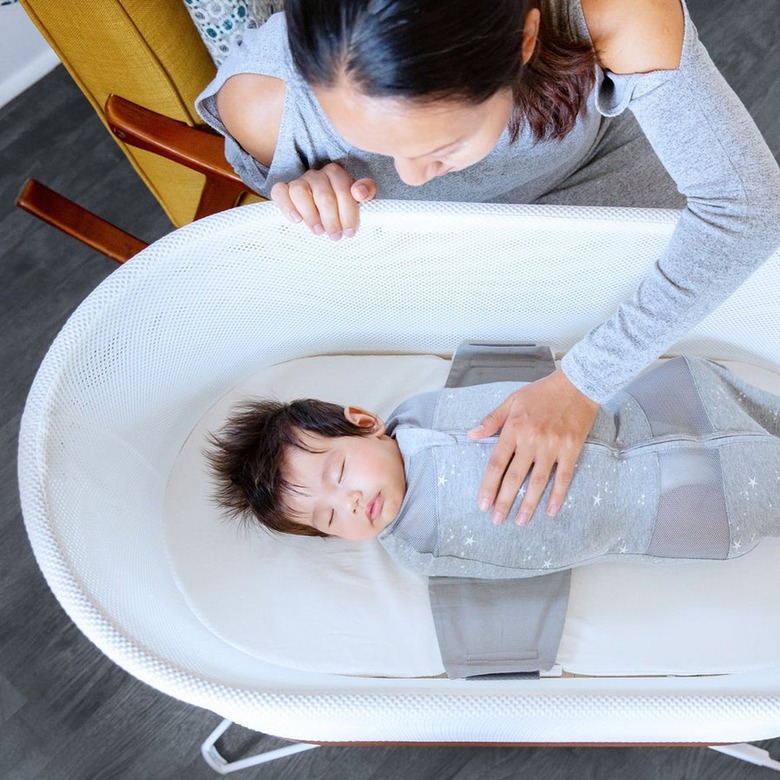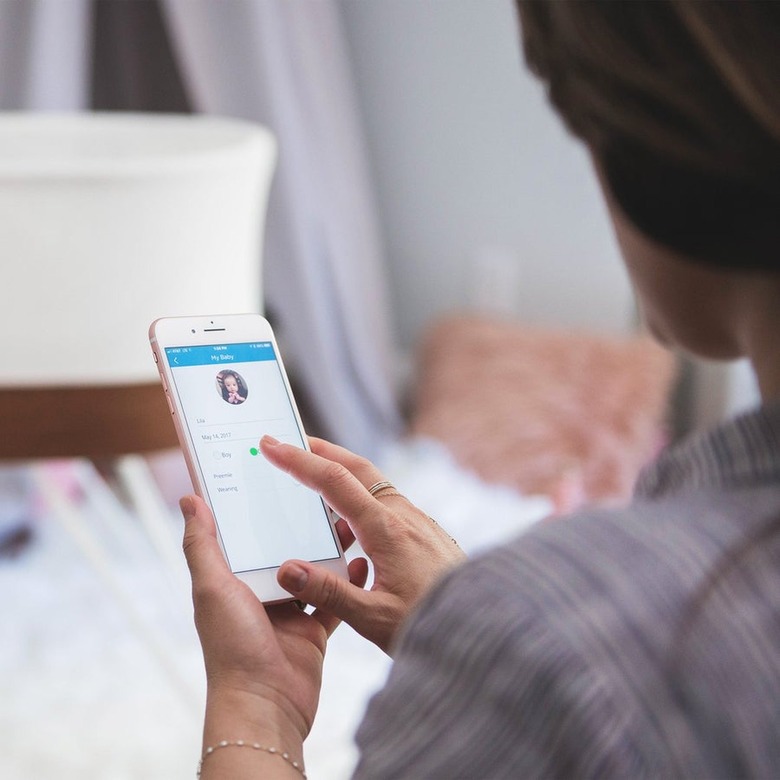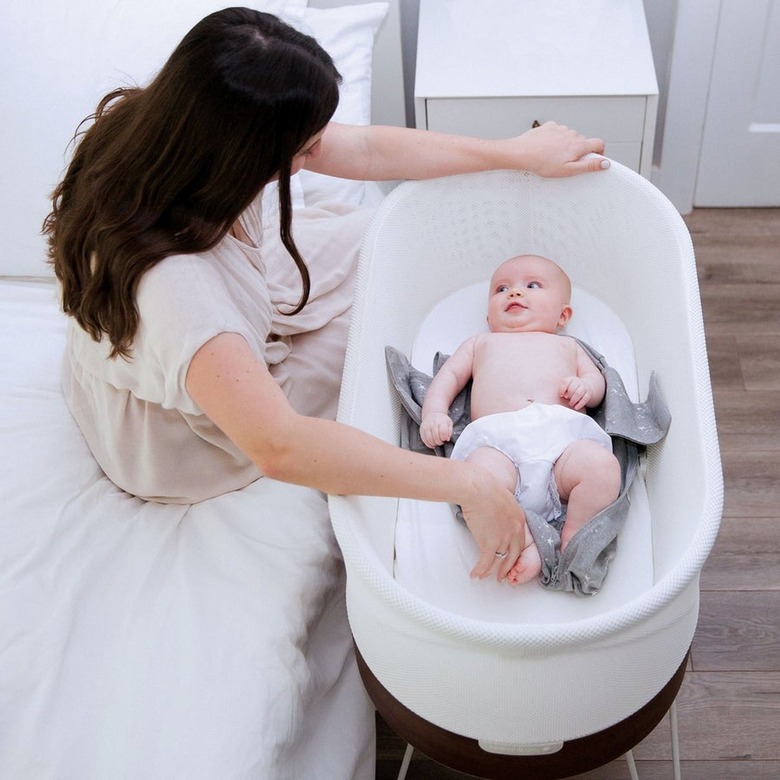Should You Get A Snoo For Your Newborn? Our Content Director Has Thoughts
We may receive a commission on purchases made from links.
Hi there! I'm a first-time mom and my kiddo is now four months old. We became Snoo users on day six of my baby's life. (Or maybe it was five or seven? Who knows ... it was all a blur.) A few weeks before she was born, I became pretty freaked out about the impending sleep loss and polled my Instagram friends as to whether or not we needed to get a Snoo. The answers were divided, and so we held off. That proved to be a mistake for us and I'll tell you why in a bit.
Keep in mind, I'm not a doctor and I'm not offering any medical advice here. All of my opinions are based off personal experience.
What Is the Snoo?
What Is the Snoo?
The Snoo is a "smart bassinet" — in a nutshell, it senses when your baby begins fussing or waking. Through sound and movement, it will try to put your babe back to sleep. It was invented by Dr. Harvey Karp, a pediatrician and sleep expert. Parents are divided on the Snoo. There are those who feel it's an absolute essential (I'm in that camp) and those who find it unnecessary (I also understand where they are coming from). Either way, what the Snoo promises is enticing to any sleep-deprived caregiver: a few extra hours of sleep per night.
The other appeal of the Snoo is that it is much sleeker than most bassinets on the market. We started off with a Halo bassinet, which my husband described as "hospital-like." The Snoo has a midcentury vibe, with hairpin legs and a teak-inspired border.
How Does the Snoo Work?
How Does the Snoo Work?
The Snoo has three main components:
- First, there's the Snoo itself: It's a bassinet with a white mesh surround that sits on four hairpin legs. The Snoo comes with two sets of legs — one shorter, one taller — so you can adjust to what feels right.
- Next there's the swaddle, which slides onto the side clips. You can't operate the Snoo unless the tubes at the side of the swaddle are properly attached to the clips. The swaddle is easy to use: A thick, Velcro band straps your infant's arms to their sides, then the entire swaddle zips up.
- Finally, you'll pair the bassinet with an app that allows you to work it remotely (although there is a manual button that can run through the different levels, I recommend using the app as you'll have far more options for customization).
Once your 'lil one is strapped in, you'll turn on the Snoo either via your app or the button at the side. This begins your "baseline," which you can customize in terms of starting motion and level of sound. There will always be a consistent, soft white noise (unless you set a timer for it), and gentle rocking (unless you select "weaning mode" ... more on that later). As your baby fusses or cries, the Snoo will sense noise and physical movement and begin to cycle through a few levels; noise and movement will increase. The first few times you operate the Snoo, you may be like, "OMG, this sounds like an angry ghost." You'll be able to track everything that's happening on your app and make any adjustments. For example, if you know your baby is about to really lose it, you might choose to skip the second level of soothing and go straight for the highest level. Or you may know they love the second or third level, and you can lock them on that one for a while. Once your kiddo reaches the highest level the Snoo will automatically turn off if your babe hasn't calmed down — a message will pop up saying that your infant needs your care.
Conveniently, your app records everything that happens in the Snoo, which is noted on an arc-shaped graph every day. It will note when you turn it on, when you turn it off, and when it's in "soothing" mode (which is marked in red). Snoo devotees aim to get a "perfect waterfall" which would show a consistent line indicating long stretches of sleep, unmarked by those red "soothing" interruptions.
How Much Is a Snoo?
How Much Is a Snoo?
The price is what puts people off of the Snoo. If you want to buy it, it will run you $1,595. Happiest Baby (the company that makes the Snoo) does offer a rental option at $149 per month (plus a one-time cleaning and reconditioning fee of $89.50 and a $99 security deposit). The Snoo rental includes the mattress, sheet set, and two Snoo swaddles. The purchase option includes the mattress, a sheet, and three Snoo swaddles (in small, medium, and large). Both options include access to sleep consultants.
You might be able to pick up a used Snoo via Craigslist (or your local Facebook parent/mom group) for around $700. Some parents who purchase the Snoo also try to maximize their profit by offering private rentals once they're done using it (but in these cases, your deal is pretty much a handshake agreement and you might not know what you're getting yourself into).
If you go the purchasing route, you can get one on Happiest Baby, or via Crate and Barrel, Dillard's, Pottery Barn Kids, or Target.
Happiest Baby recommends using the Snoo for up to six months, so in my opinion, it's best to rent if you're just planning on having one child ($149 x 6=$894 vs. $1,595). But if you are planning on having multiple children and using it for all of them, purchasing would be more cost-effective.
Is a Snoo Worth It?/My Experience
Is a Snoo Worth It?/My Experience
A few days into my daughter's life, we were already losing our minds. I'd polled my friends about whether we needed one and the answers were completely divided, so I held off. Oops. We got so desperate that I didn't even want to wait for express shipping. I posted on my Instagram asking if anyone local had one I could buy ASAP and an old friend came to the rescue; she generously loaned it to us free of charge.
The first few days with the Snoo, we really didn't feel like it was working, but we realized that was because we weren't using it properly — each time the Snoo crept up to its most intense level, it scared us so much that we turned it off. It seemed like her crying would only get worse on that level. But after we forced ourselves through it a few times (literally, my husband and I had to hold each other to get through the crying), we realized that some kind of magic would happen and all of a sudden, boom — she'd be asleep.
Granted, the Snoo wouldn't calm her 100% of the time and Happiest Baby is clear about this — it can't soothe a baby who is hungry, is uncomfortable because they did a poo, or is having an attachment issue and just needs to be held. The times that we knew she wasn't hungry and had a clean diaper, we turned on a hair dryer underneath the Snoo (on a cool setting) to help her off to sleep (we still use the hair dryer sometimes).
I'd say the Snoo worked about 70% of the time for us and was especially successful at lengthening naps.
It's also worth mentioning that the Snoo offers safety that other bassinets don't — because your baby is securely strapped in, there's pretty much zero risk of rolling over. We felt she was so safe in it that we actually transitioned her to the nursery during month two (technically not pediatrician-recommended); that helped us sleep even better.
I do feel confident that the Snoo turned our daughter into a champion sleeper. By two months, she was sleeping through the night — sometimes up to 13 hours. Of course, every child is different, but we got really lucky.
Transitioning Out of the Snoo
Transitioning Out of the Snoo
Once the Snoo started working and making everything so much easier, we instantly developed a fear of post-Snoo life — would she ever be able to sleep in her crib? After all, we had been practicing day naps in the crib and it was NOT going well. We tried everything ... putting her in a Snoo swaddle in the crib, having the Snoo on for the noise while she napped. Nope.
There is a process for transitioning your baby out of the Snoo, which involves a few tweaks over some time. You'll start with "weaning mode" which locks the movement on baseline, but not the noise. You'll then take one arm out of the swaddle and then the other. Happiest Baby recommends you wait until month five or six to try this. We made the decision to put her on "weaning mode" at month two.
Ultimately, we decided to attempt to cut the cord four weeks later over Thanksgiving when we were visiting family and going Snoo-less for a few days. She was three months at that point. For that weekend, she slept next to us in a Moses basket (probably also not pediatrician-recommended) with a Hatch sound machine and light near her head. She slept like an angel.
After that, we made the permanent transition to the crib, placing the Hatch under the crib in an attempt to create that type sound that would envelop her. She has done amazingly well, sleeping through the night. (In Snoo language, that's called a "Snoo Graduate." Pro tip: You can get all sorts of insider info on the official Snoo Parents Facebook Group. I joined it for a time but had to leave because, TBH, there were all sorts of parents still struggling with their infants' sleep and it gave me anxiety.)
I can't lie — naps are still a struggle and I have no doubt she would still be napping better in the Snoo, but we're okay with the trade-off, knowing that she's capable of sleeping the night in her crib.
The Bottom Line
The Bottom Line
For us, the Snoo was a life-saver and I wish we had had one at home the day we got back from the hospital. I'd advise renting; if your little one doesn't take to it, you can send it back. (But you'll be $238 out of pocket.)



